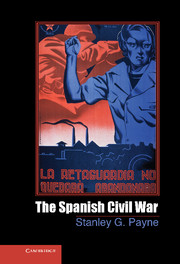Book contents
- Frontmatter
- Contents
- Chronology of Major Events
- Glossary
- Preface
- Introduction Civil War in Twentieth-Century Europe
- 1 Modernization and Conflict in Spain
- 2 From Revolutionary Insurrection to Popular Front
- 3 The Breakdown of Democracy
- 4 The Military Insurrection of the Eighteenth of July
- 5 The Battle of Madrid – the First Turning Point
- 6 Revolution
- 7 Terror
- 8 A War of Religion
- 9 Franco's Counterrevolution
- 10 Foreign Intervention and Nonintervention
- 11 Soviet Policy in Spain, 1936–1939
- 12 The Propaganda and Culture War
- 13 A Second Counterrevolution? The Power Struggle in the Republican Zone
- 14 The Decisive Northern Campaigns of 1937–1938
- 15 The War at Sea and in the Air
- 16 Civil Wars within a Civil War
- 17 The War in Perspective
- Conclusion Costs and Consequences
- Select Bibliography
- Index
- References
8 - A War of Religion
Published online by Cambridge University Press: 05 September 2012
- Frontmatter
- Contents
- Chronology of Major Events
- Glossary
- Preface
- Introduction Civil War in Twentieth-Century Europe
- 1 Modernization and Conflict in Spain
- 2 From Revolutionary Insurrection to Popular Front
- 3 The Breakdown of Democracy
- 4 The Military Insurrection of the Eighteenth of July
- 5 The Battle of Madrid – the First Turning Point
- 6 Revolution
- 7 Terror
- 8 A War of Religion
- 9 Franco's Counterrevolution
- 10 Foreign Intervention and Nonintervention
- 11 Soviet Policy in Spain, 1936–1939
- 12 The Propaganda and Culture War
- 13 A Second Counterrevolution? The Power Struggle in the Republican Zone
- 14 The Decisive Northern Campaigns of 1937–1938
- 15 The War at Sea and in the Air
- 16 Civil Wars within a Civil War
- 17 The War in Perspective
- Conclusion Costs and Consequences
- Select Bibliography
- Index
- References
Summary
It has been observed that, in some sense, most wars are “wars of religion,” to the extent that nearly all contenders make an effort to sanctify their cause, one way or the other. This was certainly the case with twentieth-century revolutionary civil wars. The Russian Bolsheviks saw the Orthodox Church as a prime enemy, whereas their White opponents emphasized the restoration of traditional religion. The White militia in Finland were largely Lutheran farmers, for whom the religious difference with their enemy was fundamental. In Hungary, the transitory Bela Kun dictatorship of 1919 went farther than the Bolsheviks in religious matters and sought to nationalize the churches directly. With all these precedents, however, religion defined the Spanish conflict in ways that went beyond any other revolutionary civil war.
In recent decades, some attempt has been made to study Spanish anticlericalism and to try to understand why it took the form of unprecedented violence. Such studies often do no more than repeat the arguments of the anticlericals themselves: that the church held tyrannical public power, that it wielded great economic dominion, that priests were abusive and hypocritical. None of these arguments held much validity for 1936: church and state had been separated for five years, the Church in Spain had long since lost most of its economic resources, and whether priests were hypocrites or good Catholics should scarcely have mattered to unbelievers. The left's hatred of Catholicism was motivated by the same feelings as those of revolutionaries and anticlerical radicals in France in 1792 and throughout the century that followed: they were convinced that the Church was the cultural and spiritual bulwark of the traditional order, and that the clergy, church buildings, and their strongest supporters were both symbolic and tangible representatives of that order, even more so than the members of conservative political and economic groups. To that extent, the motivation was itself in a certain sense religious, the expression of radical rival new secular religions, or religion substitutes – Jacobin, anarchist, and Marxist-Leninist. Bruce Lincoln has termed the phenomenon “millennial antinomianism,” expressing the revolutionaries’ sense of complete freedom from all rules, law, or morality in the establishment of their new millenarian utopia.
- Type
- Chapter
- Information
- The Spanish Civil War , pp. 111 - 118Publisher: Cambridge University PressPrint publication year: 2012



